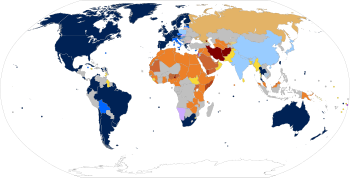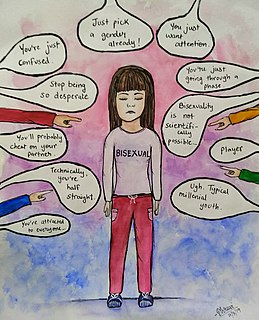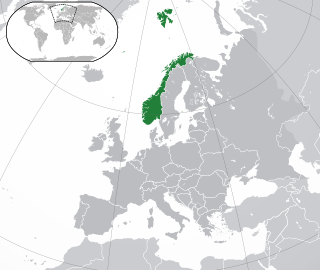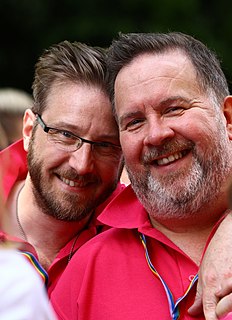| Part of a series on |
| LGBT topics |
|---|
| |
Homosexuality, as a phenomenon and as a behavior, has existed throughout all eras in human societies.
| Part of a series on |
| LGBT topics |
|---|
| |
Homosexuality, as a phenomenon and as a behavior, has existed throughout all eras in human societies.
Reliable data as to the size of the gay and lesbian population is of value in informing public policy. [1] For example, demographics would help in calculating the costs and benefits of domestic partnership benefits, of the impact of legalizing gay adoption, and of the impact of the U.S. military's Don't ask, don't tell policy. [1] Further, knowledge of the size of the "gay and lesbian population holds promise for helping social scientists understand a wide array of important questions—questions about the general nature of labor market choices, accumulation of human capital, specialization within households, discrimination, and decisions about geographic location." [1]
Measuring the prevalence of homosexuality may present difficulties. [2] The research must measure some characteristic that may or may not be defining of sexual orientation. The class of people with same-sex desires may be larger than the class of people who act on those desires, which in turn may be larger than the class of people who self-identify as gay/lesbian/bisexual. [1]
In 1948 and 1953, Alfred Kinsey reported that nearly 46% of the male subjects had "reacted" sexually to persons of both sexes in the course of their adult lives, and 37% had had at least one homosexual experience. [3] Kinsey's methodology was criticized. [4] [5] A later study tried to eliminate the sample bias, but still reached similar conclusions. [6]
Estimates of the occurrence of exclusive homosexuality range from one to twenty percent of the population, usually finding there are slightly more gay men than lesbians. [7] [8] [9] [10] [11] [12] [13] [14] [15] [16] [17] [18] [19] [20] [21]
Estimates of the frequency of homosexual activity also vary from one country to another. A 1992 study reported that 6.1% of males in Britain had had a homosexual experience, while in France the number was 4.1%. [22] According to a 2003 survey, 12% of Norwegians have had homosexual sex. [16] In New Zealand, a 2006 study suggested that 20% of the population anonymously reported some homosexual feelings, few of them identifying as homosexual. Percentage of persons identifying homosexual was 2–3%. [18] According to a 2008 poll, while only 6% of Britons define their sexual orientation as homosexual or bisexual, more than twice that number (13%) of Britons have had some form of sexual contact with someone of the same sex. [17]
In the United States, according to exit polling on 2008 Election Day for the 2008 Presidential elections, 4% of electorate self-identified as gay, lesbian, or bisexual, the same percentage as in 2004." [23] An estimated 34,000 homosexuals who are in a relationship are employed by the federal government. [24]

| Same-sex intercourse illegal. Penalties: | |
Prison; death not enforced | |
Death under militias | Prison, w/ arrests or detention |
Prison, not enforced | |
| Same-sex intercourse legal. Recognition of unions: | |
Extraterritorial marriage | |
Limited foreign | Optional certification |
None | Restrictions of expression |
Most nations do not impede consensual sex between unrelated persons above the local age of consent. Some jurisdictions further recognize identical rights, protections, and privileges for the family structures of same-sex couples, including marriage. Some nations mandate that all individuals restrict themselves to heterosexual relationships; that is, in some jurisdictions homosexual activity is illegal. Offenders can face the death penalty in some fundamentalist Muslim areas such as Iran and parts of Nigeria. There are, however, often significant differences between official policy and real-world enforcement. See Violence against LGBT people .
Although homosexual acts were decriminalized in some parts of the Western world, such as Poland in 1932, Denmark in 1933, Sweden in 1944, and the United Kingdom in 1967, it was not until the mid-1970s that the gay community first began to achieve limited civil rights in some developed countries. On July 2, 2009, homosexuality was decriminalized in India by a High Court ruling. [25] A turning point was reached in 1973 when the American Psychiatric Association removed homosexuality from the Diagnostic and Statistical Manual of Mental Disorders , thus negating its previous definition of homosexuality as a clinical mental disorder. In 1977, Quebec became the first state-level jurisdiction in the world to prohibit discrimination on the grounds of sexual orientation. During the 1980s and 1990s, most developed countries enacted laws decriminalizing homosexual behavior and prohibiting discrimination against lesbian and gay people in employment, housing, and services. On the other hand, many countries today in the Middle East and Africa, as well as several countries in Asia, the Caribbean and the South Pacific, outlaw homosexuality. In six countries, homosexual behavior is punishable by life imprisonment; in ten others, it carries the death penalty. [26]

Since the 1960s, many LGBT people in the West, particularly those in major metropolitan areas, have developed a so-called gay culture. To many, gay culture is exemplified by the gay pride movement, with annual parades and displays of rainbow flags. Yet not all LGBT people choose to participate in "queer culture", and many gay men and women specifically decline to do so. To some it seems to be a frivolous display, perpetuating gay stereotypes. To some others, the gay culture represents heterophobia and is scorned as widening the gulf between gay and non-gay people.
With the outbreak of AIDS in the early 1980s, many LGBT groups and individuals organized campaigns to promote efforts in AIDS education, prevention, research, patient support, and community outreach, as well as to demand government support for these programs. Gay Men's Health Crisis, Project Inform, and ACT UP are some notable American examples of the LGBT community's response to the AIDS crisis.
The bewildering death toll wrought by the AIDS epidemic at first seemed to slow the progress of the gay rights movement, but in time it galvanized some parts of the LGBT community into community service and political action, and challenged the heterosexual community to respond compassionately. Major American motion pictures from this period that dramatized the response of individuals and communities to the AIDS crisis include An Early Frost (1985), Longtime Companion (1990), And the Band Played On (1993), Philadelphia (1993), and Common Threads: Stories from the Quilt (1989), the last referring to the NAMES Project AIDS Memorial Quilt, last displayed in its entirety on the Mall in Washington, D.C., in 1996.
Publicly gay politicians have attained numerous government posts, even in countries that had sodomy laws in their recent past. Examples include Guido Westerwelle, Germany's Vice-Chancellor; Peter Mandelson, a British Labour Party cabinet minister and Per-Kristian Foss, formerly Norwegian Minister of Finance.
LGBT movements are opposed by a variety of individuals and organizations. Some social conservatives believe that all sexual relationships with people other than an opposite-sex spouse undermine the traditional family and that children should be reared in homes with both a father and a mother. [36] [37] There is concern that gay rights may conflict with individuals' freedom of speech, [38] [39] religious freedoms in the workplace, [40] [41] the ability to run churches, [42] charitable organizations [43] [44] and other religious organizations [45] in accordance with one's religious views, and that the acceptance of homosexual relationships by religious organizations might be forced through threatening to remove the tax-exempt status of churches whose views don't align with those of the government. [46] [47] [48] [49]
Critics charge that political correctness has led to the association of sex between males and HIV being downplayed. [50]
In 2006, the American Psychological Association, American Psychiatric Association and National Association of Social Workers stated in an amicus brief presented to the Supreme Court of California: "Gay men and lesbians form stable, committed relationships that are equivalent to heterosexual relationships in essential respects. The institution of marriage offers social, psychological, and health benefits that are denied to same-sex couples. By denying same-sex couples the right to marry, the state reinforces and perpetuates the stigma historically associated with homosexuality. Homosexuality remains stigmatized, and this stigma has negative consequences. California's prohibition on marriage for same-sex couples reflects and reinforces this stigma". They concluded: "There is no scientific basis for distinguishing between same-sex couples and heterosexual couples with respect to the legal rights, obligations, benefits, and burdens conferred by civil marriage." [51]

Policies and attitudes toward gay and lesbian military personnel vary widely around the world. Some countries allow gay men, lesbians, and bisexual people to serve openly and have granted them the same rights and privileges as their heterosexual counterparts. Many countries neither ban nor support LGB service members. A few countries continue to ban homosexual personnel outright.
Most Western military forces have removed policies excluding sexual minority members. Of the 26 countries that participate militarily in NATO, more than 20 permit openly gay, lesbian and bisexual people to serve. Of the permanent members of the United Nations Security Council, three (United Kingdom, France, the United States) do so. The other three generally do not: China bans gay and lesbian people outright, Russia excludes all gay and lesbian people during peacetime but allows some gay men to serve in wartime (see below). Israel is the only country in the Middle East region that allows openly LGB people to serve in the military.
Prior to the repeal of Don't Ask Don't Tell, the question of homosexuality in the military was highly politicized in the United States. However, such politicization did not occur in many other countries, as sexuality in these cultures is considered a more personal aspect of one's identity than in the United States.
According to American Psychological Association empirical evidence fails to show that sexual orientation is germane to any aspect of military effectiveness including unit cohesion, morale, recruitment and retention. [52] Sexual orientation is irrelevant to task cohesion, the only type of cohesion that critically predicts the team's military readiness and success. [53]
On March 18, 2010, after U.S. President Obama announced that he wanted to put an end to the Don't Ask, Don't Tell policy, former U.S. general and high ranking NATO official John Sheehan blamed homosexuals serving in the Dutch military for the fall of Srebrenica to Serb militias in the Bosnian War fifteen years earlier, stating that homosexuals had weakened the Dutch UN battalion charged with protecting the enclave. In the U.S. Senate, Sheehan said that European countries had tried to "socialize" their armed forces by letting people serve in the army too easily, which according to him, left them weakened. He claimed that his opinion was shared by the leadership of the Dutch armed forces, mentioning the name "Hankman Berman", most probably referring to the then chief of the Dutch defence staff, Henk van den Breemen. [54] Dutch authorities dismissed Sheehan's statements as "disgraceful" and "total nonsense". [55] [56] [57] [58] [59]
Though the relationship between homosexuality and religion can vary greatly across time and place, within and between different religions and sects, and regarding different forms of homosexuality and bisexuality, current authoritative bodies and doctrines of the world's largest religions generally view homosexuality negatively. This can range from quietly discouraging homosexual activity, to explicitly forbidding same-sex sexual practices among adherents and actively opposing social acceptance of homosexuality. Some teach that homosexual orientation itself is sinful, [60] while others assert that only the sexual act is a sin. Some claim that homosexuality can be overcome through religious faith and practice. On the other hand, voices exist within many of these religions that view homosexuality more positively, and liberal religious denominations may bless same-sex marriages. Some view same-sex love and sexuality as sacred, and a mythology of same-sex love can be found around the world. Regardless of their position on homosexuality, many people of faith look to both sacred texts and tradition for guidance on this issue. However, the authority of various traditions or scriptural passages and the correctness of translations and interpretations are hotly disputed.
In many cultures, homosexual people are frequently subject to prejudice and discrimination. Like members of many other minority groups that are the objects of prejudice, they are also subject to stereotyping, which further adds to marginalization. The prejudice, discrimination and stereotyping are all likely tied to forms of homophobia and heterosexism, which is negative attitudes, bias, and discrimination in favor of opposite-sex sexuality and relationships. Heterosexism can include the presumption that everyone is heterosexual or that opposite-sex attractions and relationships are the norm and therefore superior. Homophobia is a fear of, aversion to, or discrimination against homosexual people. It manifests in different forms, and a number of different types have been postulated, among which are internalized homophobia, social homophobia, emotional homophobia, rationalized homophobia, and others. [61] Similar is lesbophobia (specifically targeting lesbians) and biphobia (against bisexual people). When such attitudes manifest as crimes they are often called hate crimes and gay bashing.
Negative stereotypes characterize LGB people as less romantically stable, more promiscuous and more likely to abuse children, but there is no scientific basic to such assertions. Gay men and lesbians form stable, committed relationships that are equivalent to heterosexual relationships in essential respects. [51] Sexual orientation does not affect the likelihood that people will abuse children. [62] [63] [64] Claims that there is scientific evidence to support an association between being gay and being a pedophile are based on misuses of those terms and misrepresentation of the actual evidence. [63]
In the United States, the FBI reported that 15.6% of hate crimes reported to police in 2004 were based on perceived sexual orientation. Sixty-one percent of these attacks were against gay men. [65] The 1998 murder of Matthew Shepard, a gay student, is one of the most notorious incidents in the U.S.
LGBT parenting is when lesbian, gay, bisexual, and transgender (LGBT) people are parents to one or more children, either as biological or non-biological parents. Gay men face options which include: "foster care, variations of domestic and international adoption, diverse forms of surrogacy (whether "traditional" or gestational), and kinship arrangements, wherein they might coparent with a woman or women with whom they are intimately but not sexually involved." [66] [67] [68] [69] LGBT parents can also include single people who are parenting; to a lesser extent, the term sometimes refers to families with LGBT children.
In the 2000 U.S. Census, 33 percent of female same-sex couple households and 22 percent of male same-sex couple households reported at least one child under eighteen living in their home. [70] Some children do not know they have an LGB parent; coming out issues vary and some parents may never come out to their children. [71] [72] LGBT parenting in general, and adoption by LGBT couples may be controversial in some countries. In January 2008, the European Court of Human Rights ruled that same-sex couples have the right to adopt a child. [73] [74] In the U.S., LGB people can legally adopt in all states except for Florida. [75]
Although it is sometimes asserted in policy debates that heterosexual couples are inherently better parents than same-sex couples, or that the children of lesbian or gay parents fare worse than children raised by heterosexual parents, those assertions find no support in the scientific research literature. [51] [76] There is ample evidence to show that children raised by same-gender parents fare as well as those raised by heterosexual parents. More than 25 years of research have documented that there is no relationship between parents' sexual orientation and any measure of a child's emotional, psychosocial, and behavioral adjustment. These data have demonstrated no risk to children as a result of growing up in a family with 1 or more gay parents. [77] No research supports the widely held conviction that the gender of parents matters for child well-being. [78] It is well-established that both men and women have the capacity to be good parents, and that having parents of both genders does not enhance adjustment. The methodologies used in the major studies of same-sex parenting meet the standards for research in the field of developmental psychology and psychology generally. They constitute the type of research that members of the respective professions consider reliable. [62]
The family studies literature indicates that it is family processes (such as the quality of parenting and relationships within the family) that contribute to determining children's well-being and 'outcomes', rather than family structures, per se, such as the number, gender, sexuality and co-habitation status of parents. [79] If gay, lesbian, or bisexual parents were inherently less capable than otherwise comparable heterosexual parents, their children would evidence problems regardless of the type of sample. This pattern clearly has not been observed. Given the consistent failures in this research literature to disprove the null hypothesis, the burden of empirical proof is on those who argue that the children of sexual minority parents fare worse than the children of heterosexual parents. [80]
Professor Judith Stacey, of New York University, stated: “Rarely is there as much consensus in any area of social science as in the case of gay parenting, which is why the American Academy of Pediatrics and all of the major professional organizations with expertise in child welfare have issued reports and resolutions in support of gay and lesbian parental rights". [81] These organizations include the American Academy of Pediatrics, [77] the American Academy of Child and Adolescent Psychiatry, [82] the American Psychiatric Association, [83] the American Psychological Association, [84] the American Psychoanalytic Association, [85] the National Association of Social Workers, [51] the Child Welfare League of America, [86] the North American Council on Adoptable Children, [87] and Canadian Psychological Association (CPA). CPA is concerned that some persons and institutions are mis-interpreting the findings of psychological research to support their positions, when their positions are more accurately based on other systems of belief or values. [88]
The vast majority of families in the United States today are not the "middle-class family with a bread-winning father and a stay-at-home mother, married to each other and raising their biological children" that has been viewed as the norm. Since the end of the 1980s, it has been well established that children and adolescents can adjust just as well in nontraditional settings as in traditional settings. [62]

Heterosexuality is romantic attraction, sexual attraction or sexual behavior between people of the opposite sex or gender. As a sexual orientation, heterosexuality is "an enduring pattern of emotional, romantic, and/or sexual attractions" to people of the opposite sex; it "also refers to a person's sense of identity based on those attractions, related behaviors, and membership in a community of others who share those attractions." Someone who is heterosexual is commonly referred to as straight.

Sexual orientation is an enduring pattern of romantic or sexual attraction to persons of the opposite sex or gender, the same sex or gender, or to both sexes or more than one gender. These attractions are generally subsumed under heterosexuality, homosexuality, and bisexuality, while asexuality is sometimes identified as the fourth category.

Biphobia is aversion toward bisexuality and bisexual people as individuals. It is a form of homophobia against those in the bisexual community. It can take the form of denial that bisexuality is a genuine sexual orientation, or of negative stereotypes about people who are bisexual. Other forms of biphobia include bisexual erasure.
Heterosexism is a system of attitudes, bias, and discrimination in favor of female–male sexuality and relationships. It can include the presumption that other people are heterosexual or that female–male attractions and relationships are the only norm and therefore superior.

The field of psychology has extensively studied homosexuality as a human sexual orientation. The American Psychiatric Association listed homosexuality in the Diagnostic and Statistical Manual of Mental Disorders (DSM) in 1952, but that classification came under scrutiny in research funded by the National Institute of Mental Health. That research and subsequent studies consistently failed to produce any empirical or scientific basis for regarding homosexuality as anything other than a natural and normal sexual orientation that is a healthy and positive expression of human sexuality. As a result of this scientific research, the American Psychiatric Association declassified homosexuality as a mental disorder in 1973. Upon a thorough review of the scientific data, the American Psychological Association followed in 1975 and also called on all mental health professionals to take the lead in "removing the stigma of mental illness that has long been associated" with homosexuality. In 1993, the National Association of Social Workers adopted the same position as the American Psychiatric Association and the American Psychological Association, in recognition of scientific evidence. The World Health Organization, which listed homosexuality in the ICD-9 in 1977, removed homosexuality from the ICD-10 which was endorsed by the 43rd World Health Assembly on 17 May 1990.

Societal attitudes toward homosexuality vary greatly across different cultures and historical periods, as do attitudes toward sexual desire, activity and relationships in general. All cultures have their own values regarding appropriate and inappropriate sexuality; some sanction same-sex love and sexuality, while others may disapprove of such activities in part. As with heterosexual behaviour, different sets of prescriptions and proscriptions may be given to individuals according to their gender, age, social status or social class.

Obtaining precise numbers on the demographics of sexual orientation is difficult for a variety of reasons, including the nature of the research questions. Most of the studies on sexual orientation rely on self-reported data, which may pose challenges to researchers because of the subject matter's sensitivity. The studies tend to pose two sets of questions. One set examines self-report data of same-sex sexual experiences and attractions, while the other set examines self-report data of personal identification as homosexual or bisexual. Overall, fewer research subjects identify as homosexual or bisexual than report having had sexual experiences or attraction to a person of the same sex. Survey type, questions and survey setting may affect the respondents' answers.

Lesbian, gay, bisexual, and transgender (LGBT) persons in Cambodia face legal challenges not experienced by non-LGBT residents. Same-sex sexual activity is legal in Cambodia. Cambodia provides no anti-discrimination protections for LGBT people, nor does it prohibit hate crimes based on sexual orientation and gender identity.
Homophobia encompasses a range of negative attitudes and feelings toward homosexuality or people who are identified or perceived as being lesbian, gay, bisexual, or transgender (LGBT). It has been defined as contempt, prejudice, aversion, hatred or antipathy, may be based on irrational fear, and is also related to religious beliefs.

Homosexuality is romantic attraction, sexual attraction, or sexual behavior between members of the same sex or gender. As a sexual orientation, homosexuality is "an enduring pattern of emotional, romantic, and/or sexual attractions" to people of the same sex. It "also refers to a person's sense of identity based on those attractions, related behaviors, and membership in a community of others who share those attractions."

Norway, like the other Scandinavian countries, is very progressive in regards to lesbian, gay, bisexual and transgender (LGBT) rights. In 1981, Norway became one of the first countries in the world to enact an anti-discrimination law explicitly including sexual orientation. Same-sex marriage, adoption, and assisted insemination treatments for lesbian couples have been legal since 2009. In 2016, Norway became the fourth country in Europe to pass a law allowing the change of legal gender for transgender people solely based on self-determination.

LGBT parenting refers to lesbian, gay, bisexual, and transgender (LGBT) people raising one or more children as parents or foster care parents. This includes: children raised by same-sex couples, children raised by single LGBT parents, and children raised by an opposite-sex couple where at least one partner is LGBT.

Lesbian, gay, bisexual, transgender, and other non-cisgender or non-heterosexual (LGBT) persons in El Salvador face legal and social challenges not experienced by non-LGBT residents. Same-sex sexual activity of all genders are legal in El Salvador, but same-sex couples and households headed by same-sex couples are not eligible for the same legal protections available to opposite-sex married couples.
Gay affirmative psychotherapy is a form of psychotherapy for non-heterosexual people, specifically gay and lesbian clients, which focuses on client comfort in working towards authenticity and self-acceptance regarding sexual orientation, and does not attempt to "change" them to heterosexual, or to "eliminate or diminish" same-sex "desires and behaviors". The American Psychological Association (APA) offers guidelines and materials for gay affirmative psychotherapy. Affirmative psychotherapy affirms that homosexuality or bisexuality is not a mental disorder, in accordance with global scientific consensus. In fact, embracing and affirming gay identity can be a key component to recovery from other mental illnesses or substance abuse. Clients whose religious beliefs are interpreted as teaching against homosexual behavior may require some other method of integration of their possibly conflicting religious and sexual selves.
A mixed-orientation marriage is a marriage between partners of differing sexual orientations. The broader term is mixed-orientation relationship, sometimes shortened to MOR or MORE.

A same-sex relationship is a romantic or sexual relationship between people of the same sex. Same-sex marriage refers to the institutionalized recognition of such relationships in the form of a marriage; civil unions may exist in countries where same-sex marriage does not.

Bisexuality is romantic attraction, sexual attraction, or sexual behavior toward both males and females, or to more than one gender. It may also be defined to include romantic or sexual attraction to people regardless of their sex or gender identity, which is also known as pansexuality.
Research has found that attempted suicide rates and suicidal ideation among lesbian, gay, bisexual, transgender (LGBT) youth are significantly higher than among the general population.

The following outline offers an overview and guide to LGBT topics.

Domestic violence in same-sex relationships is a pattern of violence or abuse that occurs within same-sex relationships. Domestic violence is an issue that affects people of any sexuality, but there are issues that affect victims of same-sex domestic violence specifically. These issues include homophobia, internalized homophobia, HIV and AIDS stigma, STD risk and other health issues, lack of legal support, and the violence they face being considered less serious than heterosexual domestic violence. Moreover, the issue of domestic violence in same-sex relationships has not been studied as comprehensively as domestic violence in heterosexual relationships. However, there are legal changes being made to help victims of domestic violence in same-sex relationships, as well as organizations that cater specifically to victims of domestic violence in same-sex relationships.
{{cite web}}: CS1 maint: archived copy as title (link)claiming that homosexuality is an unchosen "condition," rather than a sin of the heart, [...] contradicts the teaching of Scripture that both the desire and the act are sin.